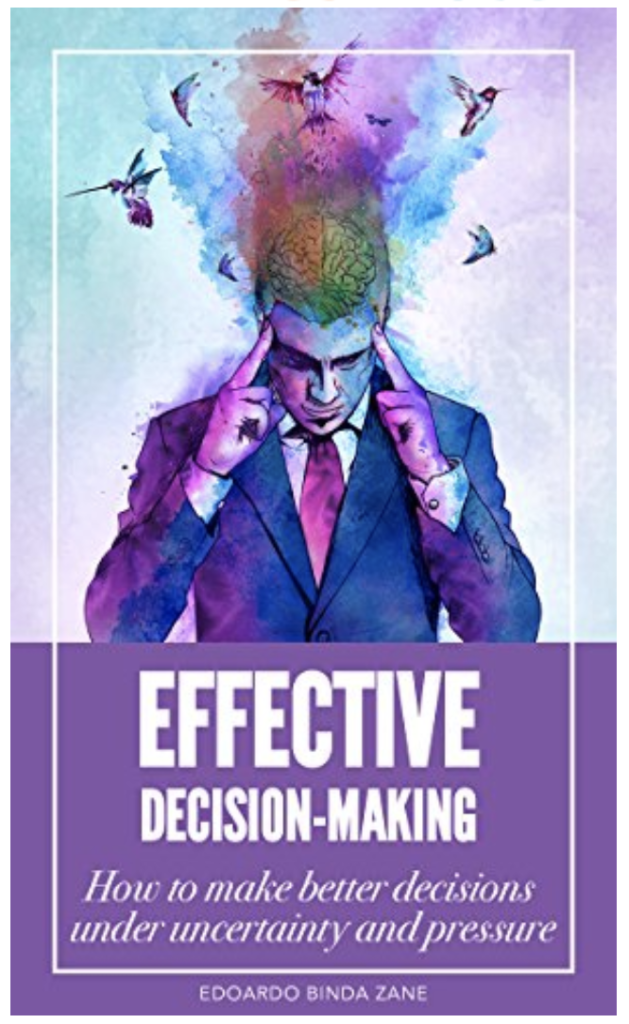
Effective Decision-Making เป็นเรื่องของการตัดสินใจ ในช่วงชีวิตของเราต้องผ่านการตัดสินใจบ่อยครั้งจนนับไม่ถ้วน แค่ในแต่ละวันเราก็ต้องตัดสินใจมากกว่า 10 ครั้งเข้าไปแล้ว ในเรื่องของการตัดสินใจ บางเรื่องก็ดูง่ายราวกับปลอกกล้วยเข้าปาก ตัวอย่างเช่น ในชีวิตประจำวัน การตัดสินใจว่าเราจะขึ้นมอเตอร์ไซค์รับจ้าง หรือเลือกที่จะเดินไปที่ทำงานเหมือนเดิมแต่หากเราเหลืออีกเวลาอีกแค่ 10 นาที มีความเสี่ยงที่จะไปทำงานสาย เราก็คงเลือกได้ไม่ยากว่าจะเลือกวิธีการใดที่จะทำให้เราไปทำงานทัน หรือ ปัญหาโลกแตกที่เกิดขึ้นทุกวันและยากเหลือเกินที่จะตัดสินใจอย่าง “กินอะไรดี?” เป็นต้น
การตัดสินใจให้เร็ว รอบคอบ และได้ผลลัพธ์ตามต้องการ ไม่ใช่เรื่องง่ายเลย เพราะอย่างที่เราก็รู้กันอยู่แล้วว่าการตัดสินใจเป็นตัวกำหนดสถานการณ์ต่อไปเสมอ อย่างเช่น เมื่อเราต้องเลือกระหว่างการกินข้าวขาหมูเป็นมื้อเย็น หรืออดข้าวไปเลยดี? ถ้าเลือกข้าวขาหมู เราอาจจะกลับบ้านไปนั่งเครียดต่อไปว่าน้ำหนักเราจะขึ้นไหม? แล้วเราอาจจะจำเป็นต้องตื่นเช้ามาเพื่อออกกำลังกายในวันถัดไป แต่ถ้าเราเลือกที่จะอดมื้อเย็น เช้าวันถัดมาเราก็อาจจะปวดท้องจากโรคกระเพาะจนอาจจะต้องเข้าโรงพยาบาลก็ได้
“เราไม่จำเป็นต้องใช้เวลาหลายเดือนหรือหลายปีเพื่อเรียนรู้วิธีการตัดสินใจที่ดี”
Effective Decision-Making: How to make better decisions under uncertainty and pressure หนังสือเล่มนี้ถูกเขียนโดย Edoardo Binda Zane เขาตั้งใจเขียนหนังสือเล่มนี้เพื่อช่วยให้เราตัดสินใจได้ดีขึ้นและอย่างรวดเร็ว ถึงแม้ว่าเราจะอยู่ภายใต้แรงกดดันที่ไม่เคยพบเจอมาก่อน หรือ อยู่ภายใต้สถานการณ์ที่ไม่แน่นอน ในหนังสือจะบอกเราด้วยขั้นตอนที่ละเอียดและเทคนิคที่ดีที่สุดในการตัดสินใจ หนังสือเล่มนี้จะทำให้คุณพร้อมเมื่อการตัดสินใจครั้งต่อไปมาถึง

“การตัดสินใจเป็นการหว่านเมล็ดของความสำเร็จ”
เราอยู่ในโลกที่เต็มไปด้วยความเร่งรีบ เรามักจะได้สัมผัสความสบายและความรวดเร็วกันจนเคยชิน แต่ทุกอย่างเมื่อมันมีข้อดี มันก็ต้องมีข้อเสียเสมอ ในการดำเนินชีวิตที่รวดเร็วเหล่านี้ ส่งผลทำให้โลกต้องการการตัดสินใจที่รวดเร็วให้ทันการหมุนของมันเช่นกัน โดยเฉพาะอย่างยิ่งเมื่อเราทำงานที่ต้องจัดการ บริหาร หรือควบคุม การตัดสินใจที่รวดเร็วและต้องการผลลัพธ์ที่ดีที่สุดมักจะมาท้าทายเราบ่อยกว่าการสั่งอาหารออนไลน์ด้วยซ้ำ
“การก้าวไปอยู่ในตำแหน่งที่ดี การตัดสินใจเป็นสิ่งจำเป็นอย่างมาก”
การเผชิญกับสถานการณ์ที่ต้องตัดสินใจในทันที ทำให้เราฉลาดพอที่จะรู้ว่าการตัดสินใจที่ดีนั้นเกิดขึ้นได้ยากเมื่ออยู่ภายใต้ความกดดัน แต่เนื่องจากธุรกิจเป็นสิ่งที่เราไม่สามารถไปชะลอความเร็วของมันได้ เราจะทำอย่างไรดี? ความกังวลเหล่านี้เกิดเป็นคำถามที่เกิดขึ้นบ่อยครั้งในการทำธุรกิจ เราจึงต้องทำให้แน่ใจว่าเราทำการตัดสินใจที่ดีที่สุดในเวลาที่เร่งด่วนและจะสร้างผลลัพธ์ที่น่าพอใจให้กับเรา ซึ่งนี่คือสิ่งที่เราต้องเรียนรู้:
- 4 กรอบอ้างอิงที่แตกต่างกันสำหรับการตัดสินใจ
- กลยุทธ์ในการตั้งเป้าหมายและบรรลุเป้าหมาย
- การวิเคราะห์ SWOT & PEST และวิธีที่สามารถช่วยองค์กรของเราได้
- 2 กลยุทธ์เสริม สำหรับการค้นหาสาเหตุของปัญหาทางธุรกิจที่สับสน และอื่นๆ อีกมากมาย
OODA Strategy
“การสังเกตอย่างระมัดระวังและใช้เวลาคิดทบทวนจะช่วยให้คุณตัดสินใจได้ดี”
การสังเกตอย่างสร้างสรรค์ และการเรียนรู้ทุกสิ่งที่เราสามารถทำได้เกี่ยวกับธุรกิจหรืออุตสาหกรรมที่เราทำงานอยู่ จะทำให้เราเป็นผู้มีอำนาจในการตัดสินใจได้ดีขึ้น ยกตัวอย่างเช่น กลยุทธ์การตัดสินใจทางทหารสำหรับการสู้รบทางอากาศอย่าง OODA ซึ่งย่อมาจาก Observe สังเกต, Orient กำหนดทิศทาง, Decide การตัดสินใจ และ Act การกระทำ กลยุทธ์นี้ออกแบบโดยพันเอกจอห์น บอยด์
“สิ่งที่คุณต้องทำในตอนสังเกตการณ์ ก็คือ การดึงเอาข้อเท็จจริงรอบตัวคุณมาใช้”
ขั้นตอนการสังเกตกำหนดให้คุณตระหนักถึงสภาพแวดล้อมของเหตุการณ์ เพื่อดูว่าอยู่ในสถานที่ถูกต้องและเหมาะสมหรือไม่ ตัวอย่างเช่น ถ้าคุณอยู่ในห้องประชุมคณะกรรมการ คุณสามารถสังเกตปฏิกิริยาของสมาชิกผู้เข้าร่วมประชุมแต่ละคนได้ มีคนใหม่เข้าร่วมประชุมหรือไม่? หน้าตาของพวกเขาบอกอะไรกับเราได้บ้าง? บรรยากาศในการประชุมตึงเครียดหรือไม่? เป็นต้น
RPD Model
Recognition-primed decision model (RPD) หรือ โมเดลการตัดสินใจที่เน้นการรับรู้ ในขั้นตอนการตัดสินใจ เราจะเปรียบเทียบตัวเลือกที่มีอยู่ทั้งหมดและสร้างภาพในใจของผลลัพธ์ที่เป็นไปได้ จากนั้นเราก็จะดำเนินการตามการตัดสินใจและวนใช้วิธีการ OODA อย่างสมบูรณ์ เรียกว่า Recognition-primed decision model (RPD) หรือ โมเดลการตัดสินใจที่เน้นการรับรู้
“โมเดล RPD มีประโยชน์ ก็ต่อเมื่อเราประสบปัญหาเดียวกันหรือปัญหาที่คล้ายคลึงกันในอดีตเท่านั้น”
โมเดลการตัดสินใจนี้ได้รับการพัฒนาโดย Gary Klein ในปี 1989 เป็นกลยุทธ์ทั่วไปที่คุณอาจเคยใช้โดยไม่รู้ตัวด้วยซ้ำ โมเดลการตัดสินใจที่เน้นการรับรู้เกี่ยวข้องกับการคิดเกี่ยวกับปัญหาและร่างหนึ่งเดียว แก้ปัญหาตามทักษะและประสบการณ์ที่ผ่านมาของเรา
“การบรรลุเป้าหมายไม่สำคัญเท่ากับการเติบโตที่เราจะได้รับในกระบวนการ”
เมื่อตั้งเป้าหมายแล้ว วิเคราะห์สถานการณ์ปัจจุบันของเราแล้วเลือกตัวเลือกที่เหมาะสมกับอุปสรรคที่ได้เจอ ตระหนักถึงความเป็นไปได้และผลลัพธ์อยู่เสมอ เลือกตัวเลือกที่มีแนวโน้มจะเป็นไปได้ที่จะให้ผลลัพธ์ที่เราต้องการมากที่สุด สิ่งนี้จะนำคุณไปสู่ผลลัพธ์ที่เราต้องการ โดยให้ตั้งคำถามว่า เราจะทำอย่างไร? โดยพิจารณาจากปัจจัยที่มีอยู่ทั้งหมด
PDSA Cycle
วัฏจักรนี้เป็นเรื่องปกติในระบบการรักษาพยาบาลส่วนใหญ่ เป็นกลยุทธ์ที่มีประสิทธิภาพและมีโครงสร้างที่ดี แต่ใช้เวลานานกว่าจะประสบผลสำเร็จ
- P ย่อมาจาก Plan การกำหนดและออกแบบวิธีการทำงานอย่างมีแบบแผน
- D ย่อมาจาก Do การลงมือทำตามแผนที่ได้วางเอาไว้
- S ย่อมาจาก Study การเรียนรู้ที่ได้จากการลงมือทำ
- A ย่อมาจาก Act การเข้าไปปรับปรุงเปลี่ยนแปลงตามผลลัพธ์ที่ได้เรียนรู้
“ถ้าไม่มีการกระทำ แสดงว่าเรายังไม่ได้ตัดสินใจอย่างแท้จริง”
เจ้าของธุรกิจใช้ประโยชน์จากเครื่องมือวิเคราะห์ต่างๆ เพื่อการตัดสินใจที่ดีขึ้น เราเองก็ต้องระมัดระวังในการตัดสินใจทางธุรกิจ การตัดสินใจบางอย่างอาจจะจริงจังพอที่จะทำให้เราเสียส่วนแบ่งทางการตลาดได้ ถ้ามันเกิดขึ้นก็อาจต้องใช้เวลาหลายปีในการทำงานและเงินจำนวนมากเพื่อให้ได้ตำแหน่งที่คู่แข่งของเราครอบครอง แต่ก็เป็นเรื่องน่าเศร้าที่บางธุรกิจไม่เคยกู้คืนสถานะของตัวเองจากความผิดพลาดบางอย่างได้เลย
การวิเคราะห์ SWOT
เป็นวิธีที่ทดลองและทดสอบแล้วสำหรับการวิเคราะห์การตัดสินใจทางธุรกิจ พิจารณาดูการตัดสินใจทางธุรกิจทุกครั้งจะมีความเกี่ยวข้องกับปัจจัยภายนอกและภายใน เมื่อเราพิจารณาถึง 2 สิ่งนี้อย่างมีวิจารณญาณ มันจะเป็นกุญแจสู่ความสำเร็จให้กับเราและองค์กรได้
ปัจจัยภายในองค์กร
- S – Strength (จุดแข็ง) : การวิเคราะห์หาจุดแข็งที่ทำได้ดีหรือปัจจัยต่างๆที่ส่งเสริมให้เกิดความแตกต่าง และสร้างข้อได้เปรียบทางธุรกิจ ไม่ว่าจะเป็นองค์กร สินค้าและบริการ หรือการทำงานของทีมงาน เป็นต้น
- W – Weakness (จุดอ่อน) : การวิเคราะห์ข้อด้อยที่ทำให้ธุรกิจเสียเปรียบในการแข่งขัน แล้วคิดหากลยุทธ์มาแก้ไขจุดด้อยที่พบเพื่อเปลี่ยนให้กลายเป็นจุดเด่น
ปัจจัยภายนอกองค์กร
- O – Opportunities (โอกาส) : การหาทางค้นพบโอกาสทางธุรกิจที่จะส่งผลดีต่อการดำเนินงาน การสร้างรายได้และการทำกำไรเพิ่มขึ้น โดยโอกาสถือเป็นปัจจัยจากภายนอกที่เกิดขึ้นเอง และมักมีการเปลี่ยนแปลงไปตามกาลเวลา การติดตามข่าวสารหรือเทรนด์ที่เกิดขึ้นทั่วโลกจึงมีความสำคัญอย่างมาก เพื่อให้มีองค์ความรู้มากพอสำหรับคาดการณ์แนวโน้มที่จะเกิดขึ้นในอนาคต และยังช่วยให้เราเตรียมตัววางกลยุทธ์สร้างโอกาสให้ธุรกิจอย่างมีประสิทธิภาพมากที่สุด
- T – Threats (อุปสรรค) : การคาดการณ์ผลกระทบเชิงลบทางธุรกิจที่เกิดจากปัจจัยภายนอก ไม่ว่าจะเป็นทั้งทางตรงและทางอ้อม ที่เสี่ยงเกิดอุปสรรคต่อการดำเนินงาน หากธุรกิจไม่ได้เตรียมตัวรับมือให้ดีพอ เสี่ยงส่งผลร้ายแรงถึงอาจทำให้การดำเนินงานหยุดชะงักหรือปิดตัวลง
“เมื่อเราเข้าใจ Strength ของเรามากขึ้น ก็จะทำให้มองเห็น Opportunities กว้างกว่าเดิม ขณะเดียวกัน เมื่อเราค้นหา Threats ได้มากขึ้นเท่าใด Weaknesses ของเราก็จะชัดเจนขึ้นเช่นกัน”
การวิเคราะห์การแข่งขันและความสามารถในการทำกำไร เป็นสิ่งสำคัญในการรักษาธุรกิจที่ดี การตัดสินใจหลายอย่างของเราจะขึ้นอยู่กับลักษณะของตลาดหรืออุตสาหกรรมที่เราอยู่ด้วย ยกตัวอย่างเช่น Apple และ Samsung คู่แข่งรายใหญ่ในพื้นที่เทคโนโลยีมือถือ รุ่น Galaxy และ Note ของ Samsung มีส่วนทำให้ยอดขาย iPhone ลดลงส่วนใหญ่ในช่วงปีที่ผ่านมา จากการแข่งขันครั้งนี้ ทั้ง 2 บริษัทจึงระมัดระวังในการตัดสินใจด้านการผลิตเป็นอย่างมาก เพราะการตัดสินใจอาจจะมีผลทำให้หนึ่งในสองบริษัทอาจจะเสียส่วนแบ่งการตลาดให้อีกฝ่ายได้
ด้วยสถานการณ์ที่ต้องแข่งขันกันแบบดุเดือด นี่คือเครื่องมือที่จะช่วยเราได้ เป็นกลยุทธ์ที่เรียกว่าแรงกดดันทั้ง 5 ของ Porter ซึ่งตั้งชื่อตามผู้พัฒนา Michael Porter เป็นเครื่องมือวิเคราะห์สภาพแวดล้อมและปัจจัยการแข่งขันของธุรกิจ 5 ประการ ดังต่อไปนี้
- ระดับการแข่งขัน ยิ่งมีการแข่งขันในอุตสาหกรรมมากเท่าใด ผลกำไรก็จะยิ่งน้อยลงเท่านั้น และการแข่งขันที่น้อยลงโอกาสที่จะได้รับผลกำไรสูงก็จะยิ่งสูงขึ้น
- ภัยคุกคามของผู้มาใหม่ บริษัทใหม่จะเข้าสู่อุตสาหกรรมของคุณได้ง่ายเพียงใด? ง่ายมาก? จากนั้นเราต้องรัดเข็มขัดให้แน่นและฉลาดขึ้น มิฉะนั้น เราจะเริ่มแพ้
- อำนาจต่อรองของผู้ซื้อ หากผู้ซื้อมีหลายทางเลือก พวกเขาจะมีอำนาจที่จะโน้มน้าวราคาได้ นักธุรกิจทุกท่านรู้ว่านี่ไม่ใช่สิ่งที่ดี
- อำนาจต่อรองผู้ผลิต ผู้ผลิตยังมีอิทธิพลต่อราคา ระดับความเชี่ยวชาญพิเศษของผู้ผลิตและความยากลำบากในการเปลี่ยนผู้ผลิตล้วนส่งผลต่ออำนาจต่อรองของซัพพลายเออร์
- สินค้าทดแทน ถ้าเรามองว่าจุดหมายของธุรกิจคือการ ‘แก้ปัญหาให้ลูกค้า’ เราก็ต้องเข้าใจว่าหนึ่งปัญหามีวิธีแก้หลายอย่าง และแรงกดดันจากสินค้าทดแทนก็คือ ‘ความง่าย’ ในการที่ลูกค้าสามารถหาสินค้าอื่นมาทดแทนแก้ปัญหาแทนการใช้สินค้าของเรา
“การวิเคราะห์สถานการณ์เป็นประจำเป็นวิธีที่ดีที่สุด เพื่อให้ทันกับแนวโน้มที่เปลี่ยนแปลงตลอดเวลาในอุตสาหกรรมของเรา”
การหาสาเหตุของปัญหา คือ กุญแจสำคัญในการแก้ไขปัญหา เทคนิคเสริม 2 อย่างที่เราสามารถใช้เพื่อค้นหาสาเหตุของปัญหาทางธุรกิจได้
- เทคนิคที่ 1 เรียกว่า “การวิเคราะห์ก้างปลา” แนวคิดพื้นฐานที่อยู่เบื้องหลังเทคนิคนี้คือการแบ่งสาเหตุของปัญหาออกเป็นหมวดหมู่ต่างๆ เพื่อให้มีสมาธิในสร้างการตัดสินใจและทางออกที่เหมาะสม จนกว่าเราจะทราบได้ว่าปัญหาของเราคืออะไร
- เทคนิคที่ 2 เรียกว่า “เทคนิค 5 ประการ” ซึ่งพัฒนาโดยนักประดิษฐ์ชาวญี่ปุ่นชื่อ Sakichi Toyoda เป็นเทคนิคง่ายๆ ที่เกี่ยวข้องกับถามเหตุผล 5 ข้อก่อนจะได้ข้อสรุป ถามหาคำตอบแล้วถามอีกซ้ำๆว่าทำไมจนกว่าจะได้คำตอบที่ 5
บทสรุป
เมื่อมีปัญหาที่ต้องแก้ไข ให้เริ่มต้นด้วยการทำให้แน่ใจว่าเราสบายใจพอที่จะคิดอย่างตรงไปตรงมาและชัดเจน ร่างกายและจิตใจของเราควรอยู่ในระดับที่เหมาะสมที่สุด หมายความว่าเราไม่ควรตัดสินใจอย่างจริงจังเมื่อเราหมดแรงหรือต้องรับมือด้วยอารมณ์ที่รุนแรง
สิ่งต่อไปที่ต้องทำหลังจากแน่ใจว่าเราอยู่ในสภาวะที่เหมาะสม ก็คือศึกษาปัญหาในมือ มองให้ครบทุกมุมก่อนเพื่อสรุป การรับฟังความคิดเห็นจากทุกคนในทีมเป็นสิ่งสำคัญหากคุณกำลังตัดสินใจแบบกลุ่ม หากเราคือผู้นำ ก็ต้องทำให้ทุกคนมั่นใจและสบายใจก่อนการตัดสินใจจะเริ่มขึ้นสมองของเรา และถ้าเราไม่รู้ว่าสมองทำงานอย่างไร? เราก็คงจะไม่ได้ใช้มันเพื่อการตัดสินใจให้ดีได้
สำหรับผู้นำธุรกิจทุกคนที่ต้องการประสบความสำเร็จในระยะยาว จำเป็นต้องเรียนรู้ที่จะมองการณ์ไกลอยู่เสมอ และ ต้องเรียนรู้วิธีการที่จะช่วยให้ตนเองสามารถตัดสินใจได้อย่างมีประสทิธิภาพได้







